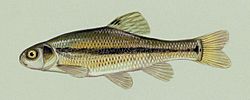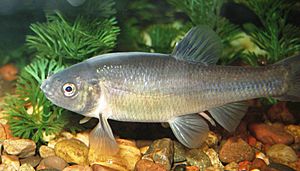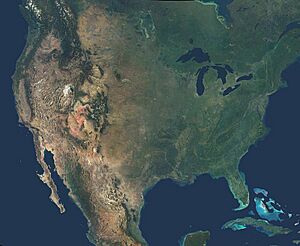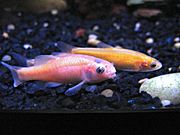Fathead minnow facts for kids
Quick facts for kids Fathead minnow |
|
|---|---|
 |
|
| Scientific classification | |
| Kingdom: | |
| Phylum: | |
| Class: | |
| Order: | |
| Family: | |
| Genus: |
Pimephales
|
| Species: |
P. promelas
|
| Binomial name | |
| Pimephales promelas (Rafinesque, 1820)
|
|
The fathead minnow (Pimephales promelas) is a type of freshwater fish. It belongs to the Pimephales genus in the cyprinid family. These fish live naturally in North America and central Canada. People have also moved them to many other areas, making them an introduced species.
Some fathead minnows are golden in color and are called rosy red minnows. They are often sold in pet stores as "feeder fish" for other pets.
Contents
What the Fathead Minnow Looks Like
In the wild, the fathead minnow is usually a dull olive-grey color. It has a dark stripe along its back and sides, and its belly is lighter. There's also a dark spot in the middle of its dorsal fin (the fin on its back).
When male fathead minnows are ready to breed, they get a large, grey, fleshy bump on their neck. They also grow about 16 white bumps called "breeding tubercles" on their snout (nose area).
Where Fathead Minnows Live
Fathead minnows can be found all over North America. They live from Chihuahua, Mexico, up to the Maritime Provinces and Great Slave Lake in Canada. They have also been brought to coastal areas in the United States.
These fish can live in many different kinds of water. They are very good at living in cloudy water or water with low oxygen. You can often find them in small lakes, ponds, and wetlands. They also live in larger lakes, streams, and other watery places.
What Fathead Minnows Eat and Who Eats Them
Fathead minnows are omnivores, which means they eat both plants and animals. They are also "benthic filter feeders." This means they sift through dirt and mud at the bottom of the water to find food.
Their animal diet includes invertebrates like insects, crustaceans, and tiny water animals called zooplankton. For their plant diet, they mostly eat algae and tiny plant-like organisms called phytoplankton. They also eat detritus, which is decaying plant and animal matter found at the bottom.
Many animals eat fathead minnows because they are a common prey fish. They are eaten by fish that eat other fish, like Largemouth Bass, Northern Pike, Yellow Perch, and Walleye.
How Fathead Minnows Warn Each Other of Danger
Fathead minnows, like some other fish, have a special "alarm substance" in their skin cells. When a predator attacks and damages these cells, the alarm substance is released into the water. Other fathead minnows nearby can smell this substance.
When they smell it, they quickly try to hide or swim away to escape the danger. Fathead minnows can also learn to recognize a predator if they see it at the same time they smell the alarm substance. If a predator eats a minnow, the alarm substance can get on the predator. This helps other minnows know that this specific animal is dangerous. This special warning system helps fathead minnows survive in places where it's hard to see, like murky water. It also helps them quickly spot predators that hide and ambush, like the northern pike.
Fathead Minnows and People
The fathead minnow has been used a lot as baitfish for fishing. More recently, a special golden color of this fish, called the rosy-red minnow, has become popular in aquariums. This color was first found on fish farms in Arkansas in 1985.
Both male and female rosy-red minnows have a rosy-golden body and fins. They might also have some dark spots like the wild fathead minnows. These rosy-red minnows are sold in pet shops, mostly as feeder fish for other pets. But they can also be kept as pets in home aquariums.
Keeping Fathead Minnows as Pets
Usually, only the rosy-red type of fathead minnow is sold in pet stores for aquariums. These fish are social, active, and quite hardy. Like most fish in their family, they will eat almost any type of fish food.
You can even breed them in an aquarium. The fathead minnow is one of the few fish in its family where the male protects the eggs in the nest. Fathead minnows usually live about two years if they breed. But they can live much longer, possibly up to four years, if they don't breed.
When kept in an aquarium, these fish need to be in a group of at least 5 or 6. If they are alone or in small groups, they might become territorial. They won't nip at other fish's fins, but they might bump their heads into other fish or chase them briefly.
Images for kids
See also
 In Spanish: Pimephales promelas para niños
In Spanish: Pimephales promelas para niños





